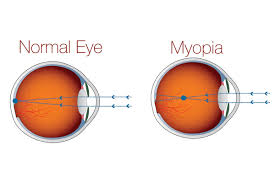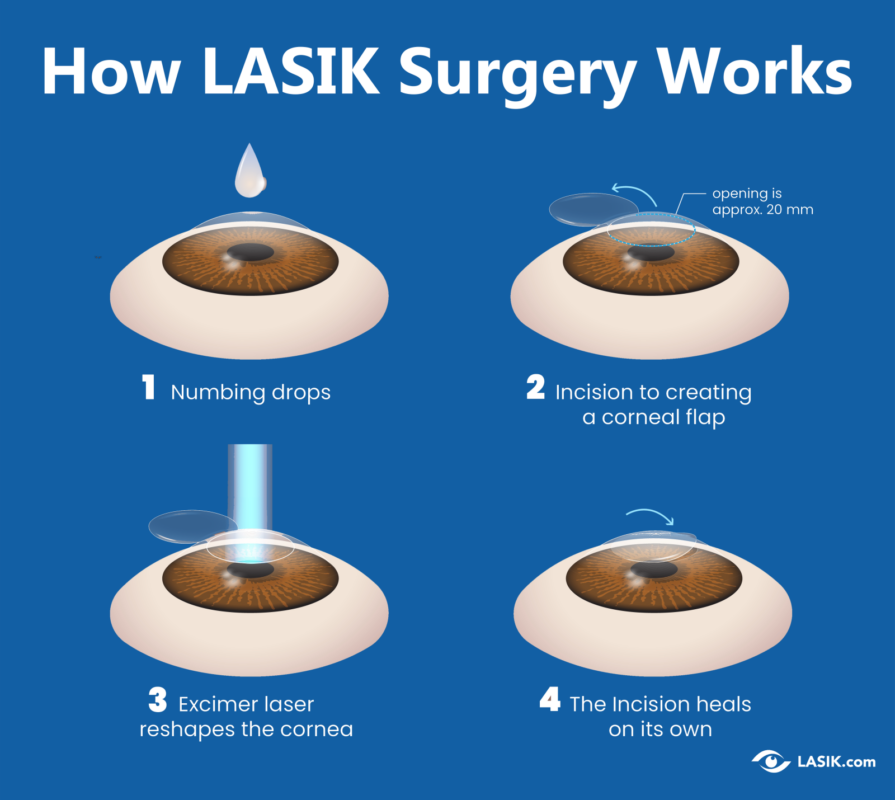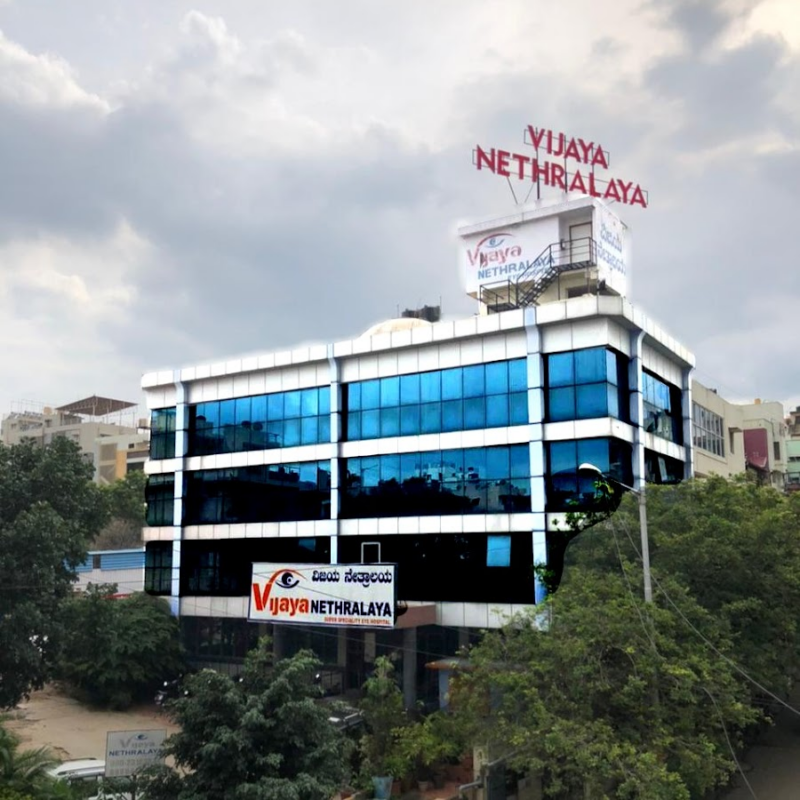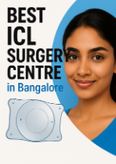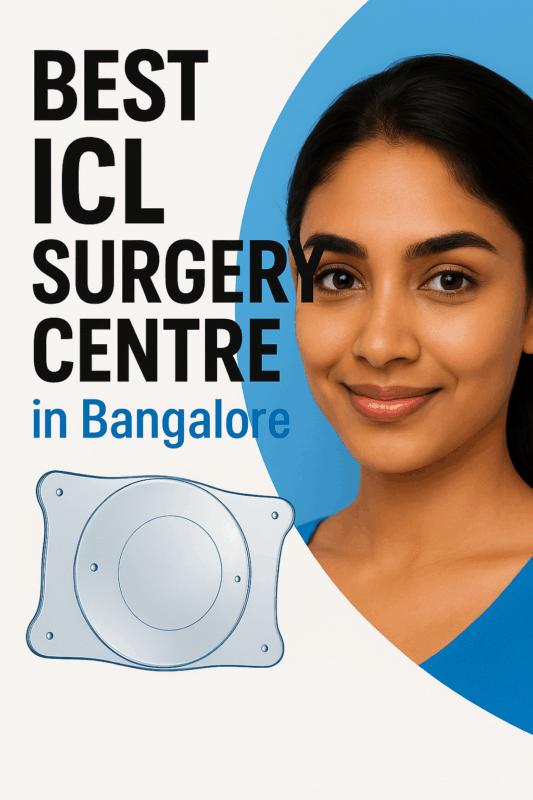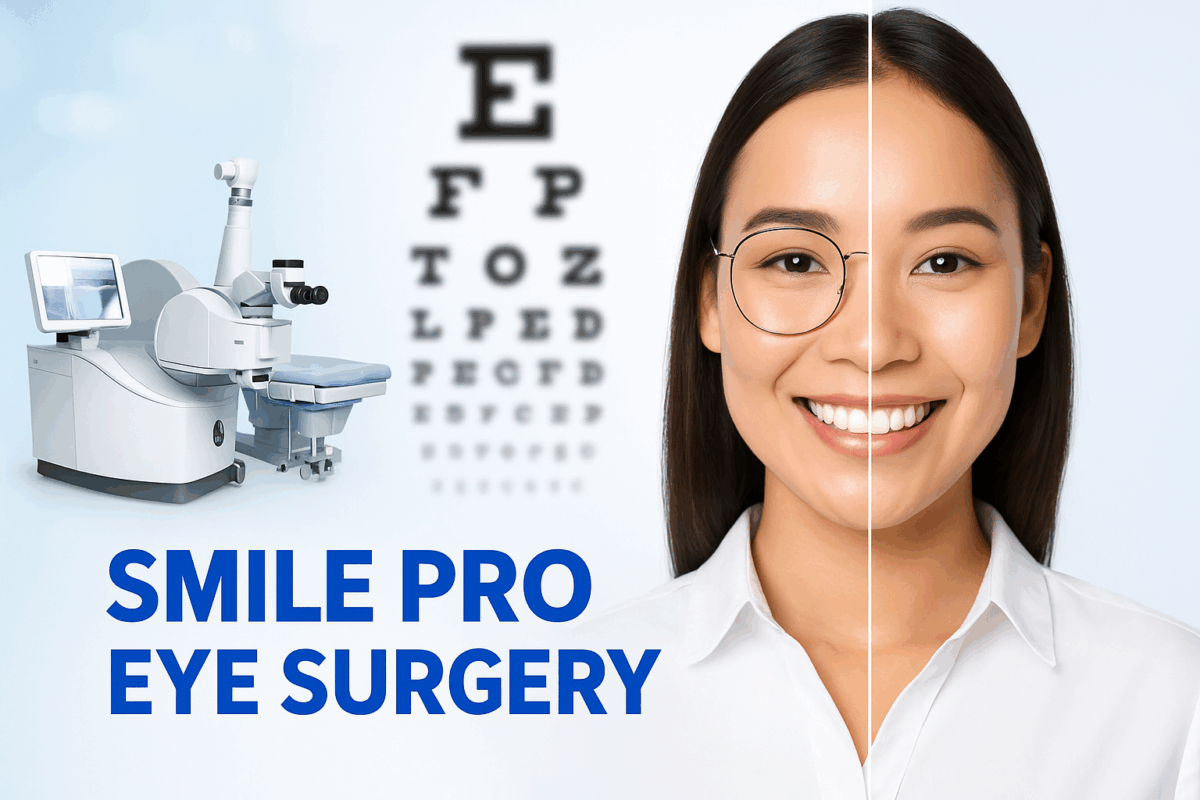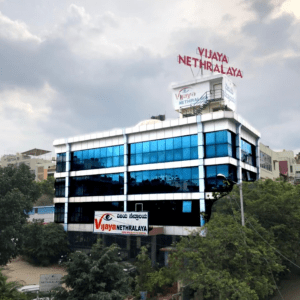Introduction
Nearsightedness, or myopia, is one of the most common vision problems in the world today. According to the World Health Organization, nearly 30% of the global population is affected by myopia, and this number continues to rise due to lifestyle changes such as increased screen time. Thankfully, advancements in eye surgery have made it possible to correct nearsightedness and reduce or eliminate the need for glasses or contact lenses. In this guide, we’ll explore the various surgical options available for treating myopia, helping you make an informed decision about which procedure might be right for you.
Overview of Nearsightedness (Myopia)
What is Myopia?
Myopia, commonly known as nearsightedness, is a refractive error in which distant objects appear blurry while close-up objects remain clear. This occurs when the eye is either too long from front to back or the cornea (the clear front surface of the eye) is too curved. These factors prevent light from focusing correctly on the retina, causing vision problems.
Causes and Risk Factors
The precise cause of myopia remains unclear, but it is generally thought to result from a blend of genetic predisposition and environmental influences. Having a family history of myopia notably raises the likelihood of developing this refractive error, suggesting a hereditary component alongside lifestyle-related factors. Additionally, lifestyle factors such as prolonged near-vision tasks (e.g., reading, using digital devices) and lack of outdoor activities in childhood may contribute to the development of myopia.
Symptoms and Diagnosis
Common symptoms of myopia include:
- Difficulty seeing distant objects clearly (e.g., road signs, TV screens)
- Frequent squinting
- Eye strain or headaches after long periods of reading or close-up work
- The need to sit closer to the TV or front of a classroom
A comprehensive eye exam, which includes tests such as refraction assessments and dilated eye exams, is used to diagnose myopia.
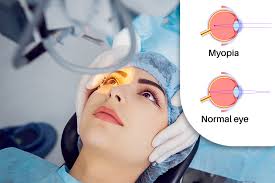
How Eye Surgery Can Correct Nearsightedness
Eye surgeries for nearsightedness work by reshaping the cornea or inserting lenses inside the eye to better focus light onto the retina. These procedures provide a permanent or long-lasting solution to myopia, potentially eliminating or reducing the need for corrective eyewear.
Importance of Choosing the Right Procedure
Selecting the right surgical procedure is critical in achieving optimal results and minimizing potential risks. Factors such as the severity of myopia, age, lifestyle, corneal thickness, and overall eye health play a significant role in determining the most suitable treatment. Consulting an experienced ophthalmologist is essential to discuss your specific needs and make an informed decision.
Understanding Nearsightedness (Myopia)
What is Myopia?
As discussed, myopia is a condition where distant objects are blurred because light entering the eye does not focus on the retina properly. This can be due to the length of the eyeball being too long or the curvature of the cornea being too steep.
Causes and Risk Factors
While genetics is a major factor, environmental influences, such as excessive screen time or lack of outdoor activities, also contribute to the progression of myopia.Research indicates that children who engage in more outdoor activities are at a lower risk of developing myopia, suggesting that exposure to natural light and distance vision play a protective role against its onset.
Symptoms and Diagnosis
If you or a loved one experiences blurred vision, squinting, or eye strain, it’s important to schedule an eye exam with an optometrist or ophthalmologist. During the exam, a doctor may conduct tests like visual acuity testing and refractive error assessment to determine the degree of myopia.
Types of Eye Surgery for Nearsightedness
There are several different types of eye surgery for nearsightedness. Below are the most commonly performed procedures:
LASIK (Laser-Assisted In Situ Keratomileusis)
LASIK is the most widely known and performed eye surgery for nearsightedness. This procedure uses a laser to reshape the cornea, allowing light to focus more directly on the retina.
How LASIK Works:
- A small flap is created on the cornea using either a microkeratome (blade) or femtosecond laser.
- An excimer laser is used by the surgeon to precisely reshape the corneal tissue beneath the surface.
- The flap is then repositioned to allow for faster healing.
Benefits of LASIK:
- Quick recovery time (often within 24-48 hours)
- High success rate (more than 95% of patients achieve 20/25 vision or better)
- Minimal discomfort
Risks and Side Effects:
- Dry eyes
- Glare, halos, or starbursts around lights at night
- Overcorrection or undercorrection of vision
PRK (Photorefractive Keratectomy)
PRK is another laser-based procedure but differs from LASIK in that it doesn’t involve creating a corneal flap.
How PRK Differs from LASIK:
- Instead of creating a flap, the outer layer of the cornea (epithelium) is removed.
- The surgeon then reshapes the cornea using a laser, and the epithelium naturally grows back within a few days.
Advantages of PRK:
- Ideal for patients with thinner corneas
- No flap-related complications
- Suitable for people with certain eye conditions
Ideal Candidates for PRK:
- People with thin corneas
- Those with higher degrees of myopia or astigmatism
- Individuals with dry eyes that prevent LASIK
SMILE (Small Incision Lenticule Extraction)
SMILE is a newer, minimally invasive procedure for treating nearsightedness.
What is SMILE?
- Using a femtosecond laser, the surgeon creates a small disc of tissue (lenticule) within the cornea.
- This lenticule is then removed through a tiny incision, reshaping the cornea to improve vision.
Benefits of SMILE:
- No need to create a corneal flap, reducing risk of flap-related complications
- Smaller incision, promoting faster healing
- Reduced risk of dry eyes compared to LASIK
Comparison with LASIK and PRK:
- SMILE is more suitable for patients with moderate to high nearsightedness
- It’s less invasive than LASIK, making it a good option for people with certain corneal issues
ICL (Implantable Collamer Lens) Surgery
ICL surgery involves implanting a lens inside the eye to correct nearsightedness.
What is ICL?
- The ICL is placed between the iris and the lens, providing an alternative to laser surgery.
Advantages Over Laser Surgeries:
- Suitable for those with high degrees of myopia or thin corneas
- The lens can be removed if needed, making the procedure reversible.
- Less risk of dry eyes
Who Should Consider ICL?
- People with thin corneas or severe refractive errors who are unsuitable for LASIK or PRK procedures.
- Those looking for a reversible solution
Preparing for Eye Surgery
Before undergoing any eye surgery, several evaluations are necessary to ensure you’re a suitable candidate:
Pre-surgery Tests and Evaluations:
- Comprehensive eye exam, including a thorough assessment of corneal thickness, eye pressure, and refractive error.
- Discuss medical history and any potential risk factors with your surgeon.
Dos and Don’ts Before the Procedure:
- Avoid wearing contact lenses for several weeks before the surgery, as they can alter the shape of the cornea.
- Follow any pre-surgery instructions provided by your surgeon.
Choosing the Right Surgeon:
- Look for a board-certified ophthalmologist with extensive experience in refractive surgery.
- Ask about the surgeon’s success rate, the technology used, and patient reviews.
What to Expect During Surgery
Each of the procedures outlined above is performed on an outpatient basis, meaning you can go home the same day.
Step-by-Step Process of LASIK, PRK, SMILE, and ICL:
- LASIK: Flap creation, corneal reshaping with laser, flap repositioning.
- PRK: Removal of epithelium, corneal reshaping with laser.
- SMILE: Creation of lenticule and small incision for its removal.
- ICL: Insertion of lens through a small incision.
Duration of Each Procedure:
- Each procedure typically takes less than 30 minutes.
Pain and Discomfort Levels:
- Most patients experience minimal discomfort during and after the surgery.
Recovery and Aftercare
Healing Time for Different Surgeries:
- LASIK: Most people recover within 24-48 hours.
- PRK: Recovery takes about 1-2 weeks, with the epithelium healing during this time.
- SMILE: Most patients recover within a few days.
- ICL: Recovery is typically quicker, but it can take several weeks for full visual stability.
Common Post-Surgery Precautions:
- Avoid rubbing your eyes.
- Apply the recommended eye drops to help prevent dryness and reduce the risk of infection.
- Wear protective eyewear, especially during the first few days after surgery.
Potential Risks and Complications
Though rare, eye surgery for nearsightedness comes with some risks:
Dry Eyes and Glare Issues:
- Dry eyes are common, but symptoms usually improve after a few months.
- Glare or halo effects around lights may occur, particularly in low-light conditions.
Overcorrection or Undercorrection:
- Some patients may require additional procedures to refine their vision.
Rare Complications:
- Infection, scarring, or issues related to the flap (in LASIK) can occur but are uncommon.
Long-Term Results and Effectiveness
How Long Does Vision Correction Last?
- In most cases, the results of surgery are permanent, but some patients may experience vision changes as they age.
Possibility of Enhancement Surgery:
- If vision changes over time, enhancement procedures are possible, particularly with LASIK or PRK.
Lifestyle Improvements After Surgery:
- Many patients enjoy a significant improvement in quality of life, with reduced dependency on glasses or contact lenses.

Cost of Eye Surgery for Nearsightedness
Price Comparison of LASIK, PRK, SMILE, and ICL:
- LASIK: $2,000–$3,000 per eye
- PRK: $1,500–$2,500 per eye
- SMILE: $2,500–$4,000 per eye
- ICL: $3,000–$5,000 per eye
Factors Affecting the Cost:
- Technology used
- Surgeon’s experience
- Location of the surgery center
Insurance and Financing Options:
- Most insurance plans do not cover refractive surgery, but financing options and payment plans are often available.
Alternatives to Surgery
- Contact Lenses and Glasses: Still the most common and non-invasive solution.
- Orthokeratology (Ortho-K): Special contact lenses worn overnight to temporarily reshape the cornea.
- Vision Therapy: Exercises designed to improve visual skills and coordination.
Conclusion
Eye surgery for nearsightedness offers a life-changing solution for millions of people worldwide. Whether you choose LASIK, PRK, SMILE, or ICL, it’s essential to consult with an experienced ophthalmologist to determine the best option based on your unique needs.
Author Details:
Dr. Sushruth Appajigowda holds a prominent position as a Cornea, Cataract, Glaucoma, and LASIK Surgeon in Bangalore. He serves as the chief Cataract and Refractive surgeon at Vijaya Nethralaya Eye Hospital, Nagarbhavi Bangalore. Renowned as one of the finest LASIK surgeons nationwide, he brings with him over 12+ years of experience across multiple LASIK platforms, including ZEISS, ALCON, SCHWIND, AMO, and Bausch and Lomb. Having successfully conducted over 5000 LASIK procedures, Dr. Sushruth holds the title of a Certified Refractive Surgeon and a Fellow of the All India Collegium Of Ophthalmology. Furthermore, he stands as a distinguished speaker at various National and International Forums, using his expertise to guide you in selecting the most suitable procedure based on your health requirements.

http://vijayanethralaya.com/link-in-bio/
FAQs
- Is eye surgery for nearsightedness painful?
No, most procedures are quick and involve minimal discomfort. Anesthesia drops are used to numb the eyes. - How long does it take to recover from LASIK?
Recovery is usually within 24–48 hours, with most people experiencing improved vision the next day. - Can myopia return after surgery?
In some cases, vision may change over time, requiring enhancements. - Who is not a good candidate for LASIK?
People with thin corneas, uncontrolled eye conditions, or severe dry eye may not be suitable candidates. - How do I choose the best eye surgeon?
Look for board certification, experience with refractive procedures, and positive patient reviews.

